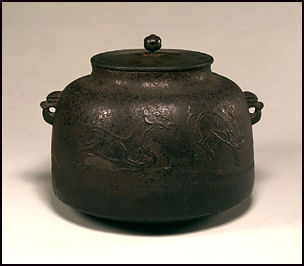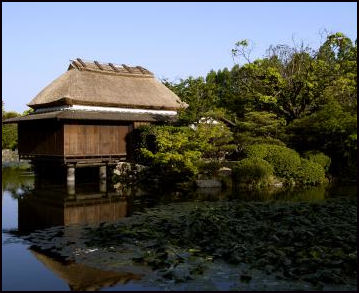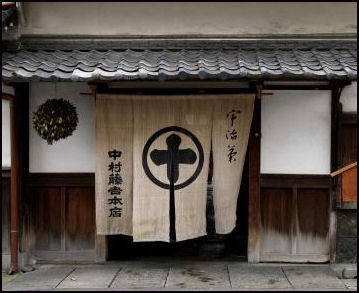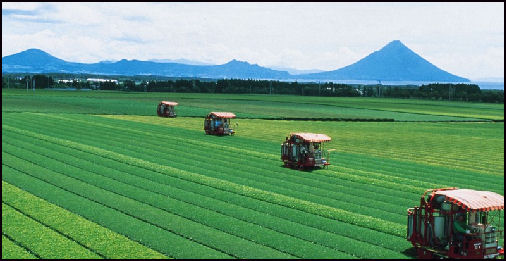TEA IN JAPAN

12th century bronze mirror tea kettle The Japanese take tea drinking quite seriously and regard themselves as experts on the matter (See Tea Ceremony). One of the first pieces written by a Japanese in English (in the late 19th century) was “The Book of Tea”, which explained why Japanese tea was superior to the teas found in other places.
The Ten Virtues of Tea
“Tea has the blessing of all deities
Tea promotes filial piety
Tea drives away all evil spirits
Tea banishes drowsiness
Tea keeps the five internal organs in harmony
Tea wards off disease
Tea strengthens friendship
Tea disciplines body and mind
Tea destroys the passions
Tea grants a peaceful death
[Source: Attributed to Japanese Buddhist priest Myoe (1173-1232), who had the words inscribed on a tea kettle, Fowler Museum at UCLA]
Tea, including green tea, mugicha, oolong tea and black tea, account for 26.7 percent of $30 billion canned and bottled nonalcoholic drink market. Kyoto and Shizuoka prefectures are Japan's main tea-growing areas. In some parts of Fukuoka Prefecture people mix the tea leaves from a finished pot of tea with soy sauce and eat it. Shichi Nasu wrote in the Daily Yomiuri, “Believe you me, the leaves are good as the tea they produced.” The leaves are said to be high in fiber and Vitamins A and E.
Japan Tea Association: www.tea-a.gr.jp/ ; Japan Central Tea Association: www.nihon-cha.or.jp
See Separate Article TEA: ITS HISTORY, HEALTH AND DIFFERENT KINDS OF TEA factsanddetails.com ; TEA CULTIVATION AND PRODUCTION factsanddetails.com ; TEA IN CHINA: HISTORY, BUSINESS AND CONNOISSEURS factsanddetails.com ; KINDS OF CHINESE TEA factsanddetails.com ;TEA DRINKING AND CULTURE IN CHINA factsanddetails.com ;TEA AGRICULTURE IN CHINA factsanddetails.com ;
History of Tea in Japan
Originating from Southeast Asia and the Yunnan province of China, tea was mentioned in a Chinese dictionary around A.D. 350. Tea processing is believed to date to around A.D. 500.

tea house Tea was brought to imperial China from Southeast Asia about A.D. 900. It became popular during Tang dynasty, when it was associated with Buddhism (monks reportedly used it to stay awake while meditating). During this period of time, tea was not prepared like it is today. The leaves were first steamed and compressed and then dried and pounded in a mortar. China still produces more varieties of tea than any other nation.
The consumption of tea spread from China to Japan and India between around A.D. 1000 or 1100, perhaps by Buddhist monks. In the 13th century, a Japanese monk named Eisai brought tea seeds to Japan from China and promoted the drink. He taught people how to cultivate tea bushes and how to process the leaves into tea. Many present-day tea plantation contain plants that can be trace back to these early seeds.
According to legend, tea was created 1,300 years ago by an Buddhist monk with bushy eyebrows, named Bodhidharma, who mediated for nine years by staring at the wall of a cave. To battle his occasional bouts of drowsiness, he drank tea and came up with the novel idea of cutting off his eyelids so his eyes wouldn't close. On the place where he placed his severed eyelids, the first tea bushes appeared. This is reportedly why tea and the tea ceremony are so important to Zen Buddhism and Japanese culture as a whole.
Tea was originally brought over as a medicine not drink. It did not become popular in Japan with the aristocracy until the 17th century and did not really catch on with ordinary people until the 18th century. In 1609 tea reached Europe via Amsterdam. The first tea arrived in Britain came from China in 1652. The British established the tea industries in India and Sri Lanka.
Japanese initially drank powdered tea. The drinking of leaf tea was first imported to Japan in the late 16th century, though not widely consumed in the country until the mid-18th century. By Ming times, Zen temples in China had stopped using the powdered green whisked tea and switched to steeped leaf tea. But Japanese still preferred the powdered tea of chanoyu that had gained converts among the upper classes.
Christal Whelan wrote in the Daily Yomiuri: The 17th century Buddhist monk Ingen is credited with introducing a new form of Buddhism and leaf tea to Japan. He also introduced new foods and culinary practices to Japan. Watermelon, lotus root and kidney beans are all accredited to Ingen. According to Shokyoku Araki, director of education at Manpukuji, the strictly vegetarian cuisine for which the temple is now famous — fucha ryori, or "food to accompany tea" — originated in temple offerings shared by priests after major religious rituals. A crucial aspect of Obaku ritual was the drinking of sencha, a general term for steeped leaf tea. [Source: Christal Whelan, Daily Yomiuri, December 4, 2011]

tea house Thomas Swick wrote in Smithsonian magazine, “In the old days processions would come through town bearing green tea for the emperor. If the tea container shattered, whoever caused the accident would be beheaded. So when a tea procession arrived, everyone stayed indoors without making a sound. Once it passed, they ran into the street to celebrate.” [Source: Thomas Swick, Smithsonian magazine, October 2010]
Zen and Tea
According to the Shanghai Museum:“Tea and Zen, one for daily use and the other concerning philosophy insights, are intricately different. Cultures of these two gradually, however, associated as a whole due to their long-time mutual touching. Tea lies in tasting while Zen calls for enlightenment. Practicing the meditation is just like savoring the tea during which one can get self-enlightenment. One can also get himself exalted via his mediation on the tea-zen culture. By one’s flashes of realization, the tea and zen share the common taste and both seek for the tranquil life and classic aesthetic sentiment. [Source: Shanghai Museum, shanghaimuseum.net]
“Harmony is the soul of tea, and the quintessence of Zen as well. Tea-drinkers usually seek for mentality in peace. When tea and zen integrated, people are able to appreciate the essence of life, harmony and the Doctrine of the Mean. Jade is endowed with five merits. Teaware made of jade, in particular, are dedicated to inspiring and promoting the harmony of humanity.
“Chinese tea is distinctive for its refined and cleansing taste, which is quite in line with the doctrine of Zen. The clearness of tea, in Zen’s view, equals to the tranquilized simplicity, which is the utmost goal of Zen. The tea ceremony, in accord with the Zen realm, also highly values the stylized elegance and inactivity. Ancestors thought of tea as a matter of clearness and voidness, interest in tea tasting is therefore called as a refined practice. Those white porcelain or celadon, in similar color as silver and jade, is undoubtedly the best utensils for tea tasting tradition.
“Stillness is the nature of tea, and the ideal realm in Zen as well. Tea, without stillness, will not have gone deep into the cultures and exalted to the religious domain. Black-glazed teacups prevailed during the Song Dynasty, despite being born for the ‘Tea Fight’, usually conveyed a sense of peacefulness which is quite in line with the quintessence of the tea-zen culture.
“Elegancy plays the rhythm of tea and evokes the delight of Zen as well. Tea and Zen share the common cultural character of their aspiration for elegancy, which is also the inherent characteristic of tea culture. Tea tasters from antiquity to today unexceptionally take the teatime chatting as a matter of gracefulness. And people during the Song Dynasty, in particular, regarded tea tasters graceful while alcoholics vulgar. The Zen advocates the easy life in peaceful mood. In ancient Chinese society, the literati usually pursued elegancy, their teaware are therefore personified with similar temperature.
“Tea gathering, or tea banquet, is a form of banquet where guests are treated with tea instead of liquor. Monks or zen hold tea banquets at temples while scholars or poets in the nature. Although the sites differ, they all got self-cultivated while tea-tasting, chatting about art and composing poems. They enjoy the fantasy of the landscape while tasting the tea and gradually integrate the taste with the beauty of the nature. Their spirit has thus been enriched and exalted and is naturally demonstrated in poem, painting and calligraphy.
Kinds of Tea in Japan
True teas (excluding so called "teas" for their plants) are divided into four categories according to methods of processing: 1) unfermented, 2) slightly fermented, 3) semi-fermented; and 4) fermented. The reference to fermentation is misleading because tea undergoes oxidation not fermentation.
Green teas are the least processed of all teas. They are steamed, rolled and dried (in Japan) or pan fried (in China) soon after picking to kill the enzymes and prevent oxidation before drying. Green tea has a slightly bitter, grassy flavor. The fragrance at first is grassy but later becomes sweet. The taste has been described as "fresh, energetic and sweet." Gyokuro is considered by some to be the finest green tea. It is often served with great deliberation. “If you put in super hot water, “you ‘insult’ the tea.” Japanese say. Slowly it is poured a little into one cup, and then the other, going back and forth in the interest of equality.
Mugicha is roasted barely tea. Makinohara-wase tea from Shimda in Shizuoka Prefecture is an extremely early tea variety. It is harvested in April bey women who pick leaves measuring five centimeters to six centimeters
Green Tea in Japan

A wide variety of green tea products are available in Japan, including Leaf tea soft drinks, green tea incense, noodles, candies, tofu and green tea cheesecake. Green-tea-flavored Haagen Daz is very popular. Starbucks recently sells Kyoto Matcha Latte — made with matcha powder and Takanashi milk.
Tea leaves in Japan can be harvested four times a year up to October, But the first picking that takes place on and around the 88th day after stsubun — the official start of spring on the Japanese calendar — is the best in quality of the year’s crop. Tea form this first prick known as “ichibancha”, or first-flush tea. In the old days this tea was regarded as a key to longevity and prescribed as a medicine.
Types of Green Tea in Japan
Tea varieties have different tastes that are determined by different cultivation methods, picking seasons, sections of the tea leaves used, and production processes. “Sencha” is regular green tea. The most widely consumed tea in Japan, it has a balanced stringent, bittersweet taste and made using steamed leaves to maintain a bright green color. “Matcha” is high quality powdered green tea used in the tea ceremony. Gyokuro is high quality tea made from the finest new leaves carefully protected from direct sunlight. It has a sweet and mellow taste.
“O-cha” is leafy green tea consumed after being steeped in a pot. “Bancha” is a brownish tea made with summer and autumn leaves and produced in way similar to sencha. “Hoicha” tea is gently roasted and has a rich aroma and mellow taste.. “Genmaicha” tea is a derivative of sencha and bancha tea combined with roasted rice. “Kukicha” and “konacha” are other kinds of green tea.

To brew good gyokuro: 1) Boil water and cool it until the temperature falls to 80 to 90 C; 2) Pour the hot water into a small kyusu teapot and wait until the temperatures drops another 10 C. 3) Fill up 80 percent of each cup with hot water from the kyusi teapot. 4) Prepare gyokuro leaves in the kyusu teapot and pour the hot water from the cups; 5) brew for about two minute to draw out the best flavor.
To brew good sencha: 1) Boil water and pour it into cups to lower the temperature from 70 to 90 C; 2) Put sencha leaves in a kyusu teapot. 3) Pour the hot water into the kyusu teapot, brewing for about one minute. To brew good hojicha: 1) Prepare leaves in a kyusu teapot. 3) Pour boiling water into the kyusu teapot and wait for about 30 seconds.
Chinese Tea in Japan
Chinese teas started to become more popular in Japan in the early 2000s. Once regarded as tasteless, they began gaining in popularity because they were different from the teas that Japanese normally drink and were considered more healthy than coffee.
Oolong, jasmine and puer teas are among the Chinese teas that Japanese favor. There are 100 shops in Tokyo alone that specialize in Chinese teas. Many department stores have large section with Chinese teas, tea pots and other tea paraphernalia.
In recent years Taiwanese teas have become quite popular, so much so that there are special tea drinking tours to Taiwan.
Christal Whelan wrote in the Daily Yomiuri: According to Sessho Doi, fifth head of the Higashi Abe lineage of senchado, more than 100 different schools of the Chinese tea ceremony are active in Japan today. Practitioners use a small pot and five tiny cups to serve multiple guests. The preferred tea is the bright jade-green colored leaf tea of gyokuro known for its fragrance and full-bodied flavor that leaves a strong aftertaste. According to Hiroaki Mizuki of Ippodo, Kyoto's classic tea purveyor, the pale green tea is meant to be "sipped slowly and savored on the tongue." [Source: Christal Whelan, Daily Yomiuri, December 4, 2011]
Japanese-Style Tea Drinking

tea-ceremony-style tea drinking The first step in drinking tea Japanese-style (not the tea ceremony) is to place all the necessary pots, cups and utensils in neat order on a small table. Fresh spring water is boiled on a special brazier and then poured into the handle-less cups and the pot to warm them — and then the water is thrown out. Water is next poured into a tea bowl so that it will be at the right temperature when the tea is ready.
The lid of the tea container is removed and placed on a special stand and the tea — about two grams per person — is placed in the pot with a special ladle and the slightly cooled water (about 70̊C to 80̊C) in the tea bowl is slowly and evenly poured into the tea pot and the lid is put back on the teapot. The tea brews for about two minutes before it is served.
The tea is then poured into ceramic cups with no handles a little bit at a time to make sure everyone receives tea of the same strength and quality. Tea drinkers are often served three cups: the first of which is fragrant, the second, strong, and the third, delicate. When a man prepares match for a woman it often has romantic implications,
Describing how tea is served at a tea tasting session at fancy tea house Elizabethan Andoh wrote in the New York Times, "A tiny clay pit holding the leaves and two small porcelain cups are brought to the table with a thermos of hot water. The teapot is set on a clay trivet, and scalding water is poured over and into the pot. (The trivet doubles as a sink, catching overflow.)"
"After a few moments the first infusion is poured into the slender and taller cup, then transferred immediately to what looks like a sake cup or shot glass. The first cup becomes a snifter — indeed the aromas are intense — and the second cup is for sipping. As the hot tea warns the cup, the design painted on the snifter changes color, from green to red."
Japanese Tea Market Trends in 2012
Kazumichi Shono wrote in the Yomiuri Shimbun: “In an effort to serve up a better cup of green tea and meet changing tastes, companies are offering bottled varieties that are as rich as if they came straight out of a teapot. Until recently, beverage manufacturers competed by removing the turbidity from tea to make it clear. However, turbidity is now the rage. Suntory Beverages & Food Ltd. plans to change the taste of "Iemon," the company's major tea brand, by adding powdered tea to make it turbid and richer. Up to now, it has been clear. [Source: Kazumichi Shono, Yomiuri Shimbun, October 1, 2012]
In the bagged green tea market, the turbid tea became popular around 2007 and the proportion of turbid tea in the market has risen to 30 percent from 25 percent before 2007. A recent Suntory survey shows that changing tastes are not limited to tea. As long as the price is the same, consumers prefer richer tastes in soft drinks and alcoholic drinks in general, according to a company spokesman. As a result of the survey, the company decided to tweak the taste of its flagship tea brand. [Ibid]
Coca-Cola (Japan) Co.'s tea brand "Ayataka," introduced to the market in October 2007, was the precursor of turbid tea. Although Coca-Cola lagged behind in the bottled green tea market, the company's green tea share grew rapidly thanks to Ayataka's popularity. According to a survey by Inryo Soken, a marketing research company, Ayataka's market share in bottled green tea in 2011 rose to third place with 14 percent, following Ito En's "Oi Ocha," which accounts for 39 percent, and Iemon with 23 percent. [Ibid]

tea-growing area of Kyushu
According to Ito En's public relations division, the company still places importance on its clear tea. However, as consumers who prefer a richer taste are increasing, the company launched "Nigori Maroyaka," a slightly turbid tea that was derived from Oi Ocha in March and "Futte Oishi 'Kyoto Uji Matcha-iri Ryokucha'" in July. Japan Tobacco Inc. followed the trend by changing its major tea brand "Tsujiri" to a turbid type in March. Kirin Beverage Co. is bucking the trend. An official said: "We have no plan to produce turbid tea. I'm sure we'll be able to keep customers who love our clear tea." In the beer industry, Asahi Breweries kept up with changing tastes by switching from bitter and rich brews to "Super Dry" beer, which dominates the market. [Ibid]
Image Sources: 1) Doug Mann, Photomann 2) xorsyst blog 3) and 7) JNTO 4) National Museum of Tokyo 5) and 6) Ray Kinnane 8) Coca-Cola 9) Wikipedia
Text Sources: New York Times, Washington Post, Los Angeles Times, Daily Yomiuri, Times of London, Japan National Tourist Organization (JNTO), National Geographic, The New Yorker, Time, Newsweek, Reuters, AP, Lonely Planet Guides, Compton’s Encyclopedia and various books and other publications.
Last updated October 2021
